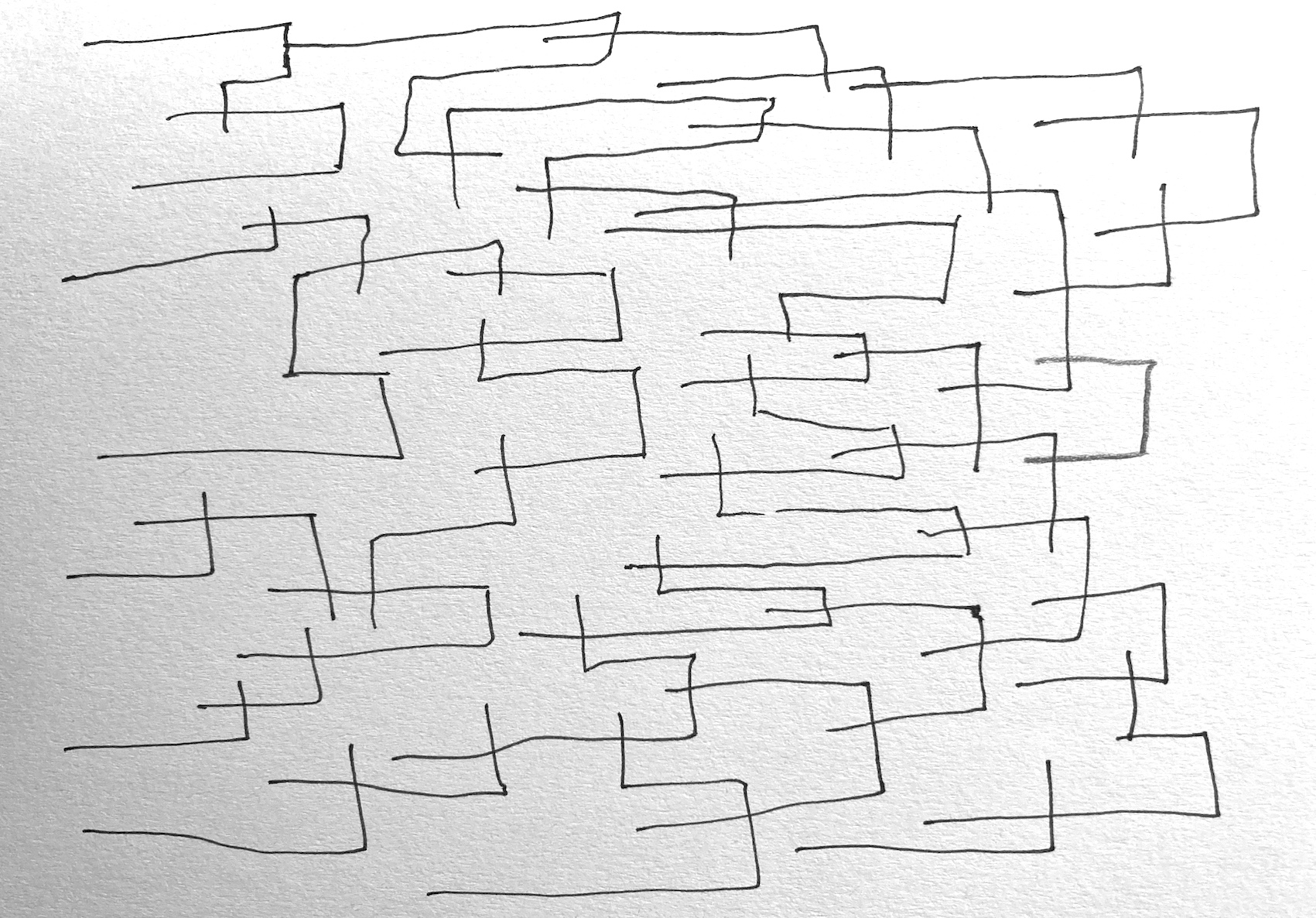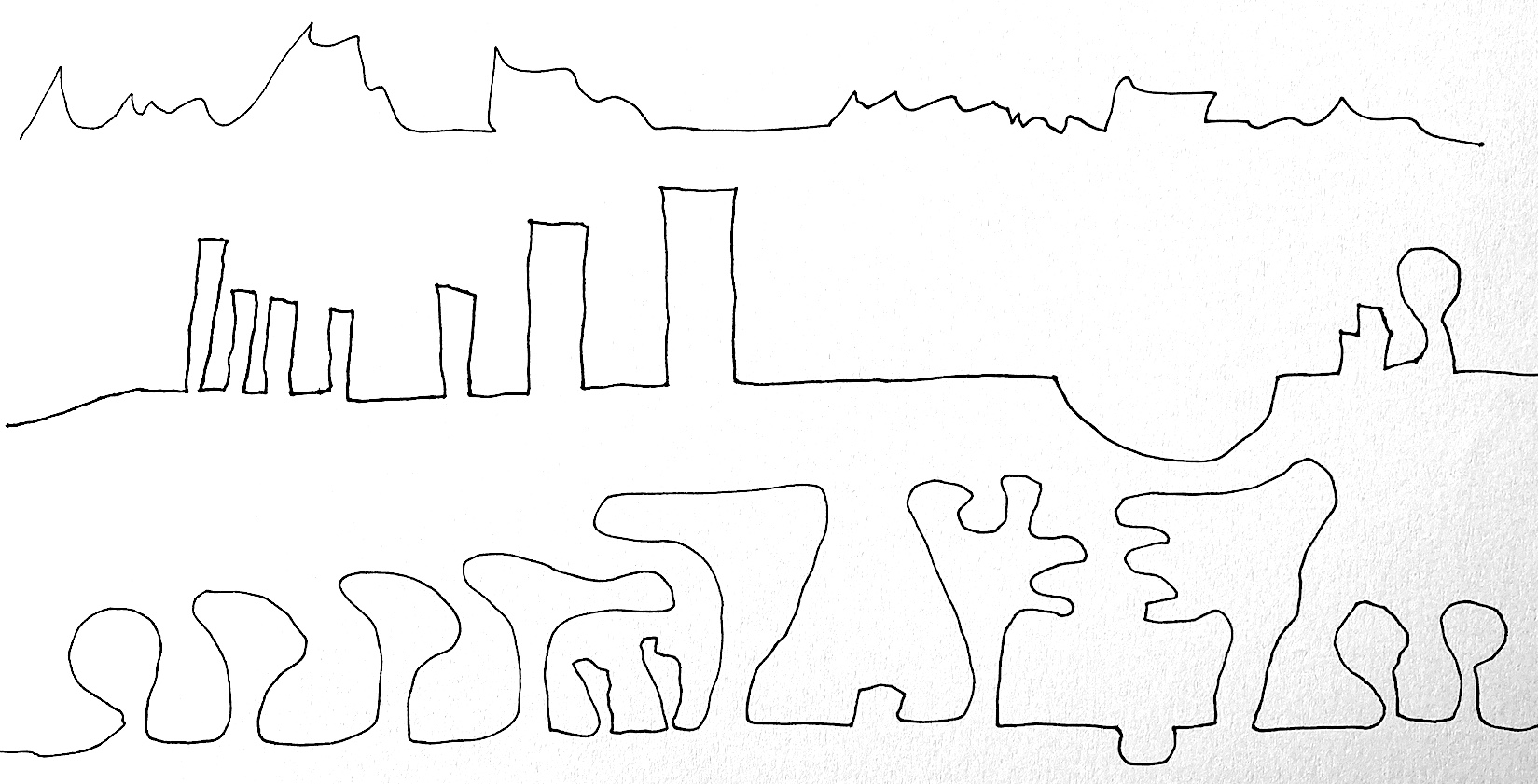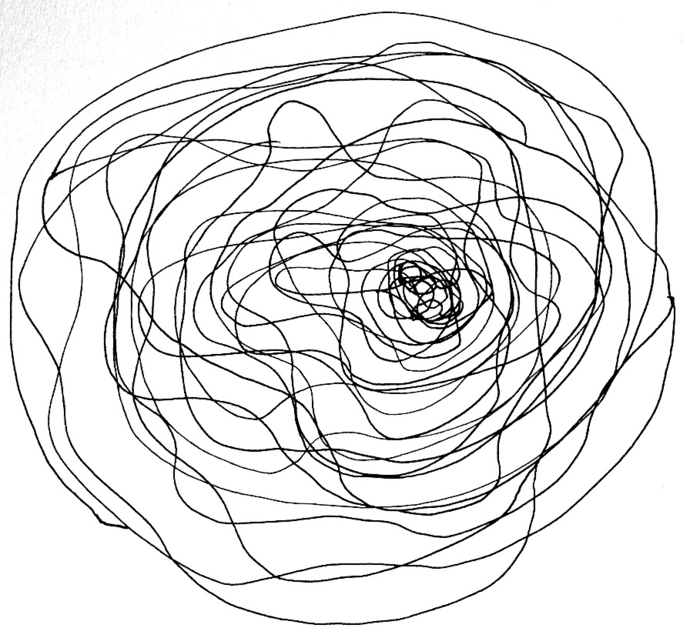In my spatial musical performances Vokal-De-Konstruktion (2017), Voiceland (2017 and 2018), Musica Munda (2018) and Demmin – letting a city sound (2018), I observed that, along with tone placing and sound building, a community was formed during each performance. It seemed to constitute itself through the listening, the sharing of the space, through the dynamic relationships among performers, between performers and audience members, and among audience members. Silent agreements in the negotiation of the space were made while time seemed to stand still and expand simultaneously when inside the music. Working with performers as well as the audience as active listening participants became an intricate part of my practice, and handling this fragile situation is important in the performances. This text engages with the fragility and the ephemerality of this part of my practice.
I often work with choirs. Working with choirs means entering an already existing community, with pre-existing social structures, support systems and dependencies. This helps when they enter unfamiliar ground in an experimental project with me. The familiar can help one to feel safe in the unknown. The trust that the singers give me is usually connected to the trust that they have in each other, and (often) more specifically in the conductor with whom I am usually in contact before meeting the choir itself.
On the other hand, when I assemble a new group for a project, like I did for Musica Munda, I usually plan for more games and improvisations in the beginning than when working with a pre-existent group. This helps to build our relationship and trust. The intention is to help performers feel safe and to learn more about each other individually and as a group in this specific context. Through musical improvisations and physical tasks we can learn what everyone is capable of alone, as well as together with someone else in the group. Through conversations we discover how each of us may relate to certain situations, and learn how to bring our personalities into the creative process. This establishes and creates awareness for individual comfort zones, which is important to know when working together in new territories.
In this early phase, I give the singers ample time to listen to each other, to what they produce. As two groups, one ‘audience’, one performing, they can experience the perspective of the free-moving audience that will later attend the performance. This contributes to their understanding of what they will give to an audience, based on the bodily experience of being a receiver. It becomes evident how varied individual preferences are, and the investigation into taking care of the audience reveals its importance. When they return to being a performer after temporarily being an audience member, they are able to take care of the audience in a new, even more individual way. People visiting our performances shall feel included. The intention is to discover together and share an experience.
The audience-performer relation is brought up regularly in conversations with participants, in order to ensure that the future audience is already present somewhere in our thinking. The audience, however, remains an unknown quantity until the end of each performance. We can prepare for certain situations, but as the audience can move freely inside the works and continuously choose their relation to the performers and their position in the space, surprises are a part of the performers’ experience. Such interaction is welcomed, as is the resultant attention this freedom brings for audience as well as performers.
During the performances, there is a spectrum of freedom. In relational theory it is described as a state in which degrees of freedom are reduced through correlation (“Relational theory,” 2021). The correlation between performers, sound, space and audience is in my work evident in the way the space is shared. The correspondence of the different entities involved is a negotiation of the space, and a negotiation between freedom and responsibility. Responsibility can limit one’s freedom but it also holds within it the ability to respond. A freedom-taking develops during the performance. It is a giving and taking of space which is explored, learnt, and understood, unfolding many possible ways in which a space can be shared. (Please also refer to relation in the dictionary)
Another aspect is the amount of space that allows for different paths and varying spatial relations to other people and elements. This is one reason why I usually work in larger spaces, and it is also a main reason why the amount of audience members per performance is limited. In order to allow for something to happen among and between the audience and the performers, there needs to be sufficient space between them. This space should not stay unchanged (as in a frontal performance), rather it changes through dynamic relationships. The movement of the singers takes an active part in the variation of this space in-between, and it stimulates the negotiation of the space. There is also a clarity in the patterns of the spatial music that gives space (for more information see The space inside music and the music inside space). The music unfolds as a sonic scenography (see sonic scenography and Opening Scenography) in a way that guides movement through it. It negotiates space through volume and positioning of sonic impressions, and it varies in ways that relate to the bodies inside the space.
Spatial musical composition (refer to Composing in Space) can work as a spatial guide as mentioned above. However, due to the way our hearing works, which always puts us at the centre, we are used to not seeing what we hear, or to not be in the place where a sound comes from. Therefore, the motivation to move does not necessarily come from a limited aural perspective as it would from a limited visual access. What comes into play here is what I call the physicality of sound or the Body of Sound (see Body of Sound in dictionary and the book). The way in which the sound takes presence in the space, how it moves and shifts shape in relation to all other elements in the space is what challenges us to listen closer, to move closer, to follow, to change perspective. It can also be the touch of sound, as musician Evelyn Glennie describes it (Riedelsheimer, 2004). This is a physical and tactile effect that certain sound waves have which can be perceived with the whole body; our skin, our bones and the blood in our veins. One example from my own oeuvre engaging with such tactility is the moment when the percussionists in Musica Munda play two hollow walls with a degree of insistence that makes the whole building seemingly vibrate. Here one does not need to move in order to experience the effect, but one also cannot escape the sensation of being embraced by these immersive vibrations. No matter where one is in the space, the vibrations of the building and in the air touch.
To maintain a certain degree of control during the performance, I create several ‘safety nets’. Before the audience enters the performance, they are welcomed by a host. This is a role that I myself often take. To preserve the possibility for a direct experience on the part of the audience, I explain the advantages of being present with us instead of documenting the piece. There is no ban of mobile phones or other devices, but I propose this as the first choice that the audience members can make for themselves and the others, since every choice we make affects others. Another recommendation the audience gets before they enter the performance is to follow their curiosity. This means to be guided by where their attention is drawn to. The only direct request I make is to turn off the sound of the mobile phones.
In the construction of the spatial sound compositions, there are parts integrated that affect the audience’s ways of being in the space. Some parts allow for stillness and rest, while there are other parts that activate the awareness of other audience members and the performers in the space. The way the singers perform guides the way the audience behaves. The experience the performers have during the preceding workshop (described in Composing in space and in art projects) is now embodied by them and communicated through them. The care that the performers give to the audience and the situation becomes evident in the way that they perform physically and sonically. The relationship the performers have with the space is an attentive one. This attentive care is passed onto an attentive audience. I call this practice space care (dictionary). The way the performers listen to the space, to each other and to the newly arrived, creates an atmosphere for listening. Their individuality in performing allows for individuality in the receiving. As Édouard Glissant puts it beautifully in his Poetics of Relation: “Each and every identity is extended through a relationship with the Other” (Glissant and Wing, 1997, p.11). It is therefore through each other that one can find different ways of being in the performance.
A phenomenon that I love to see is when audience members look at each other in order to seek confirmation of the situation they find themselves in. This can happen when sharing something funny, being surprised or seeing someone deeply moved, and connecting with these ‘strangers’ momentarily.
Since in spatial musical composition the dialogue with the space and with the acoustics of the architecture play an important role, the presence of the space is constantly confirmed in its performance. The space welcomes and steadily reveals its character to everyone present through spatial interactions. The performance space and the choreography of the bodies and the voices of the singers (or other instrument sounds) in the space allow for, and stimulate, activity in the audience. In addition, they can prevent some kinds of activities. The behaviour of the audience depends on the spaces we perform in, and this informs the amount of options available for being together in the space.
In performances there is a tendency for some of the audience to find ‘their place’ and remain there unless they are encouraged to move by the performers. There are parts in some of my performances where the singers have the task of disrupting this fixed position in order to motivate the audience to change perspective. For example, during the ‘Time is money’ section of Voiceland the singers’ movement through the space shifts direction often and some of their paths run closely along the walls.
As sociologist Martina Löw describes in her text ‘The Constitution of Space’, “People are positioned by the actions of others, and they also actively position themselves” (Löw, 2008, p.35). When the listening-to-each-other is enhanced in my work, we can position ourselves by ear. This positioning expands into a full-body listening. We feel how the bodies around us move, the smell of a perfume may pass by, one may have to take care of someone sitting on the floor when walking past. In this respect the space is constantly changing, not only by the performers and the sounds they create, but also by the audience who reacts to a selection of impressions. Martina Löw describes how social interaction creates spaces, and “that space arises from the activity of experiencing objects as relating to one another” (Löw, 2008, p.26). The network of connections that derives from the interaction in and with the space is the open-ended result of active relation-shaping.
In site-sensitive works an important aspect of my approach is to acknowledge a given space as it is, the way it appears to us. Simultaneously, I create a sonic space through the spatial composition of sounds in relation to the space, the choreography of sound, and bodies in the space. Here I imply parallel forms; simultaneous appearances that produce space.
Martina Löw explains that the duality of space means that “spaces do not simply exist but are created in action”, and guide action simultaneously (Löw, 2008, p.40). This includes the actions of the audience. Active in their own ways, all agents together form a territory of constant action and reaction. The singers have paths, rules, tasks, positions and their voice. All these factors are negotiated in relation to the audience. The choreography facilitates how a performance may be perceived, often in subtle ways. The physical presence of the performers, and/or the physical presence of the sound created by the performers, has the potential to guide the audience physically in the space. Low volume or the occupation of a limited space can trigger the audience’s curiosity and motivate them to move closer to a performance area. If we want the audience to experience a certain part of the piece from a specific perspective or in a certain area without telling them directly to follow us there, we have several means to motivate them. This does not mean that the performers need to reach everybody. When we reach some, their reaction informs the others. However, there is always the possibility of following individual needs and desires. For example, if an audience member wants to spend the whole performance sitting in the middle of the space and experiencing how things move around him/her, this is a welcome way of being in the space. In my spatial musical performances, the negotiation of individual needs and desires, and the care for the wellbeing of the group are a central part of the experience for the performers and the audience. Choice, however, comes with responsibility. This may mean that in the centre one gets more attention from others than if one is flexible in the space. Umberto Eco calls this availability suggestiveness, meaning that the way the addressee can respond is open. This includes the “emotional and imaginative resources of the interpreter” (Eco, 1989, p.9). A single agenda or meaning is not desired in my work. The performances instead stimulate empathy and imagination. The relations the audience members develop with the site, the performers and sound when encountering the performance, define meaning - individually and collectively. The “social dimension of the participation”, as Claire Bishop describes it in her book Participation, is not explicit in my work. To Claire Bishop the social dimension of participation is enabled by an emphasis on “collaboration and the collective dimension of social experience” (Bishop, 2006, p.10). In my work this dimension is implicit. It is embodied by the performers and inscribed in the way that the music unfolds spatially. The spatial performance is created with a care for the audience. It surrounds the group entirely and performs for each individual in a subtle way that respects individual choices.
I see that which is created here as being related to ‘atmosphere’, in the sense in which Gernot Böhme uses the term. To him it is a “shared reality of the perceiver and the perceived” (Böhme and Engels-Schwarzpaul, 2018, p.23). Atmosphere is here “something emanated from and produced by things, people and their constellations” (Böhme and Engels-Schwarzpaul, 2018, p.23). It is through everybody’s involvement in this frame of time and space that the participation of the performers and the audience members creates a community in my spatial sound performances. This community is as ephemeral as the music that binds it together. It is an unstable and diverse intersubjectivity that is nonetheless fixed to site. With intersubjectivity I mean here “the sharing of experiential content (e.g., feelings, perceptions, thoughts, and linguistic meanings) among a plurality of subjects” as described by Jordan Zlatev and his colleagues (Zlatev, 2008, p.2).
The vulnerability of each individual is exposed in my spatial sound performances because proximity makes us more accessible to each other, both audience and performers. In my project Demmin – letting a city sound, the aged voices of the elderly performers made their vulnerability tangible.
When creating invisible structures, changing forms, moving buildings, evolving landscapes and other fluid connections with sound, we create vulnerable entities. Their instability and fragility ask for care. I believe that this is a valuable motivator in the communal behaviour I have observed during the performances. Xavier Le Pichon suggests that carefully attending to weakness is an “essential quality that allowed humanity to evolve” (Le Pichon, 2016). My hope is that the memory of the experience of this ephemeral community can extend beyond a performance-specific experience out into other contexts, and can resonate in how we act, react and interact in other spaces and communities.
References:
Bishop, C. (Ed.), 2006. Participation, Documents of contemporary art. Whitechapel Gallery, London.
Böhme, G., Engels-Schwarzpaul, A.-C., 2018. Atmospheric architectures: the aesthetics of felt spaces. Bloomsbury Visual Arts, London New York Oxford New Delhi Sydney.
Eco, U., 1989. The open work. Harvard University Press, Cambridge, Mass.
Glissant, É., Wing, B., 1997. Poetics of relation. University of Michigan Press, Ann Arbor.
Le Pichon, X., 2016. The Fragility at the Heart of Humanity.
Löw, M., 2008. The Constitution of Space. The Structuration of Spaces through the Simultaneity of Effect and Perception. Eur. J. Soc. Theory - EUR J SOC THEORY 11, 25–49. https://doi.org/10.1177/1368431007085286
Relational theory, 2021. https://en.wikipedia.org/wiki/Relational_theory
Riedelsheimer, T., 2004. Touch the Sound.
Zlatev, J. (Ed.), 2008. The shared mind: perspectives on intersubjectivity, Converging evidence in language and communication research. John Benjamins Pub. Co, Amsterdam ; Philadelphia.
Back to the portal



